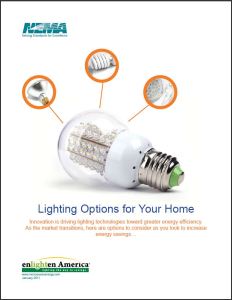Home Lighting
By Susan Bloom

Image by National Electrical Manufacturers Association
If you’re “in the dark” about recent lighting legislation and how it affects your home, you’re not alone. A 2011 survey sponsored by OSRAM SYLVANIA recently revealed that many homeowners—nearly one-half of those surveyed—are still unaware of energy-efficient lighting legislation passed in 2007 that will effectively eliminate most traditional incandescent lamps (light bulbs) by 2014.
The National Electrical Manufacturers Association (NEMA) has stepped in to help explain the new lighting mandates and homeowners’ subsequent lighting choices in their educational brochure, “Lighting Options for the Home.” Published in partnership with the “Enlighten America” campaign, “Lighting Options for the Home” is an invaluable resource designed to help consumers understand what the new legislation means, when it will take effect, what their lighting replacement options are and how to apply them in a variety of residential settings.
According to the brochure, the 2007 Energy Independence and Security Act (EISA) was enacted to reduce the nation’s energy usage and greenhouse gas emissions and promote greater energy independence. One of the provisions of EISA established efficiency standards for several types of lamps. Because popular 100-W, 75-W, 60-W and 40-W incandescent lamps don’t meet the new efficiency standards, they’re set to be phased out on a rolling basis, with 100-W models phased out January 1, 2012, 75-W models following in 2013, and 60-W and 40-W models phasing out in 2014.
Currently, homeowners can replace their incandescent bulbs with the following three types of energy-efficient lighting technology that are detailed in the brochure:
- Halogen lamps: A more energy-efficient form of incandescent lighting, halogen lamps provide at least 28-30% energy savings relative to incandescent lamps and are the most similar to incandescent technology in look and feel. They’re also reasonably priced, fully dimmable and contain no mercury, though their lifespan is shorter than CFLs or LEDs.
- Compact fluorescent lamps (CFLs): Consuming 75% less energy and lasting six to 16 times longer than incandescent or halogen bulbs, CFLs are available in a wide variety of wattages, color temperatures and shapes. Not all CFLs can be used in all incandescent applications, however, and, because CFLs use fluorescent technology, they contain a very small amount of mercury to ensure proper operation. As a result, CFLs must be disposed of in accordance with state and/or municipal hazardous waste ordinances.
- Light emitting diodes (LEDs): Several companies make LED replacements for today’s 25-W to 100-W incandescent bulbs. While not all LEDs are dimmable or suitable for use in all applications, they’re mercury-free and deliver roughly 80% energy savings as well as extremely long life—from 25,000 to 50,000 hours—compared to the incandescent bulbs they replace.
NEMA’s “Lighting Options for the Home” brochure offers simple visual guidelines for replacing your incandescent bulbs in a typical home setting—from installing CFLs in attics, garages and basements, to adding halogen bulbs above eat-in kitchen tables and LEDs in decorative foyer chandeliers.
Click here to download the brochure free.
What You Need To Know About Energy-Efficient Home Lighting Options
- Energy legislation is targeting traditional incandescent lamps, creating new choices
- Many consumers remain confused about energy-efficient home lighting options
- New NEMA brochure outlines energy-efficient lighting options for the home
- Options include halogen, compact fluorescent and LED